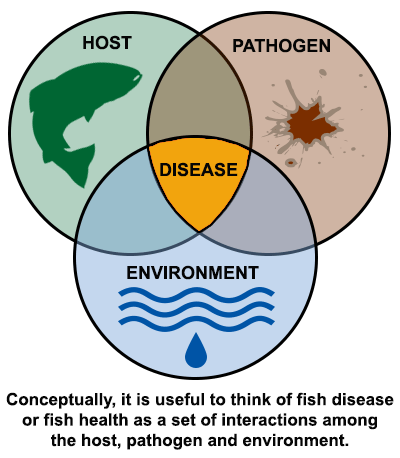Vermont's Fish Health program helps protect wild fish populations and fish reared at fish culture stations by preventing and managing serious fish diseases.

The program is responsible for:
- Conducting annual fish health inspections on all state owned and private fish culture stations and investigating specific diseases when they occur on facilities.
- Developing statutes and regulations designed for preventing and managing serious fish diseases.
- Administering Vermont's fish importation and fish propagation permit programs.
- Investigating fish kills and studying fish disease agents in the natural environment.
- Providing technical assistance in fish heath related matters to fisheries staff and the public.
- Operating a fish health laboratory equipped to diagnosis many parasitic, bacterial and viral fish pathogens.
- Participating in the Northeast Fish Health Committee
Fish Health Laboratory
The department's fish health laboratory is equipped to diagnosis many parasitic, bacterial and viral fish pathogens. The laboratory is currently located in Randolph at the Vermont Agriculture and Environmental Laboratory.
Vermont Agriculture & Environmental Laboratory
163 Admin Drive
Randolph Center, VT 05061
Please report fish kills and any abnormal fish condition to the Vermont Fish & Wildlife Department.
Common Fish Health Questions
What are the tiny black, yellow or white grubs in the fish that I catch? Are these fish safe to eat?
These are small parasites known as Digenetic Trematodes and are commonly called Black Spot, Yellow Grub and White Grub. They are often found in many fish species in Vermont waters and worldwide. The parasites have a complex life cycle that involves fish, water dwelling birds, and other invertebrates such as snails. They are not known to infect humans and have negligible impact on fish populations. There is no known cure for these parasite in natural waters.
Why are the trout dying in my small, private pond?
Summer-related fish kills - This condition often occurs in small, shallow ponds that heat up during periods of extended hot weather. Warm water holds little oxygen and trout suffocate.
Winter-related fish kills - This condition is often noticed shortly after ice-out. Low oxygen levels can occur in the winter under the ice, particularly if there is a thick ice and snow cover. Winterkill is most common in highly vegetated, nutrient rich ponds.
What caused the fish kill in a particular body of water in Vermont?
The Vermont Fish & Wildlife Department annually documents fish kills, most of them related to natural causes. They can be classified as three basic types: Winter Kill, Spring Kill, and Summer Kill.
These events can have low oxygen levels associated with them, but with spring and summer kills fish death, is usually related to a combination of stressful factors that overwhelm the fish's immune system. These factors include: rapidly fluctuating water temperatures, low oxygen levels due to extremely high water temperatures, strenuous spawning activity, toxic algae blooms. unbalanced fish populations, poor nutrition and fish diseases.
Occasionally, fish kills are related to the illegal dumping of toxic substances. Examples include numerous substances generated by industrial, municipal, agricultural and transportation industries.
Fish Health Fact Sheets
View these factsheets for more information about some of the more common fish disease found in Vermont.
- Black Spot | PDF
- Blue Spot in Northern Pike | PDF
- Columnaris | PDF
- Esocid Lymphosarcoma | PDF
- Lymphocystis | PDF
- Heterosporis | PDF
- Red Worm | PDF
- Tapeworm | PDF
- Viral Hemorrhagic Septicemia Virus
- Whirling Disease | PDF
- Yellow Grub | PDF
- Guidelines for Fish Health Management in Northeastern States | PDF
